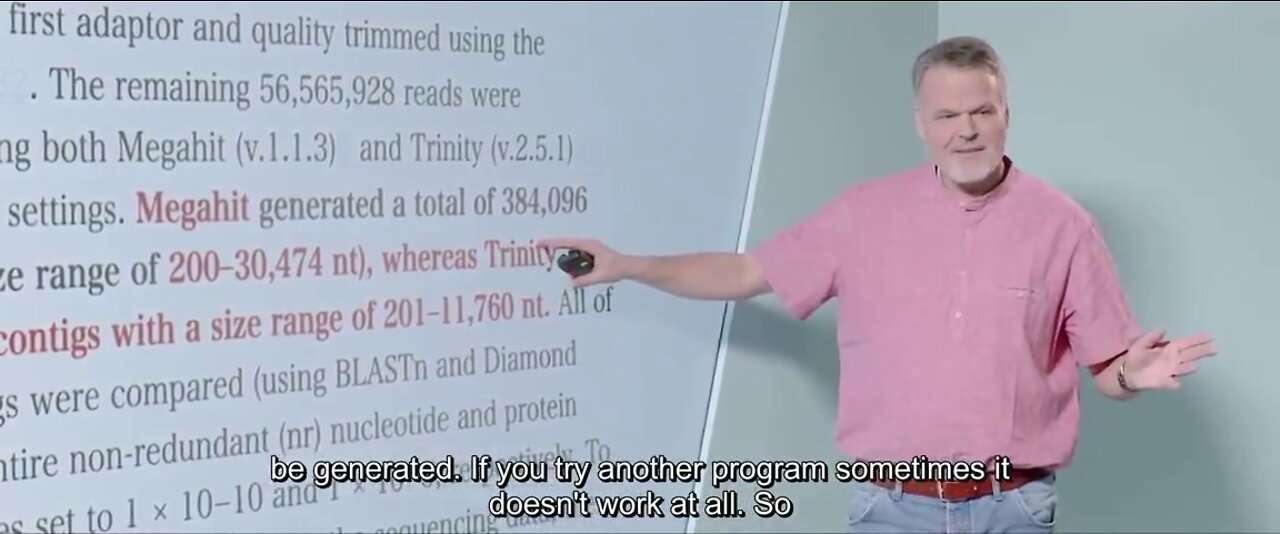Premium Only Content

Microbiologist Stefan Lanka: 98.5% of 'clean' SARS-CoV-2 genome also present in humans
The genetic code (genome) of all viruses, including the so-called new corona virus (SARS-CoV-2), has been determined using a process called assembly.
Researchers never find the whole intact genetic code, but only tiny fragments. They feed the genetic code from all these fragments into specialized software running on a powerful computer, which then searches for overlapping parts in the code. By adding pieces, you slowly get a better picture of the whole, like a large linear jigsaw puzzle coming together.
NB: This assembly process is similar to making a panorama photo. First you take multiple photos. Then you search for overlapping parts in the individual photos and paste ('stitch') them together in the right location to assemble a panorama image.
According to microbiologist Stefan Lanka, there are multiple severe problems with the determination of the SARS-CoV-2 genome.
The SARS-CoV-2 genome was determined using Chinese software called Megahit. However, if you feed the exact same source data into any of the other 49 assembly software packages, NONE are able to find the same genome. Said differently, the assembly process cannot be replicated. This is a severe red flag.
Second of all, the genetic code of the individual fragments has been determined using a multiplication process called PCR (Polymerase Chain Reaction), which is the same process used to determine COVID 'infections'. Specialized primers are mixed with the test sample. The primers latch on to specific segments of genetic code if they are present. The specific segments are doubled a number of times by heating and cooling cycles of the fluid. In the process 1 segment becomes 2, 2 become 4, 4 become 8, 8 become 16, etc.
This process becomes exponentially less reliable with progressive heating and cooling cycles. First of all, the primers degrade fast after about 14 cycles, causing them also attach to pieces of genetic code for which they were not meant (i.e. the primers become less specific). Now the risk increases of the wrong pieces of code being multiplied.
Also, even the tiniest contamination (introduced during ANY part of the test process, e.g. primer manufacturing, sample taking, analysis) or manufacturing fault in the primer, is likely to cause problems with higher cycles. For example, you could end up with a whole bunch of copies of contamination or of the wrong genetic fragment (if there was a manufacturing error in the primer).
Up to 14 cycles, the PCR-test delivers reliable results. Lanka calls this 'clean PCR'. The result quickly loses reliability above 14 cycles. Lanka uses the term 'dirty'. Anything above 30 cycles is completely dirty, while anything above 45 cycles is completely unscientific. Above 30 cycles, the PCR test becomes a highly advanced piece of junk. Above 45 cycles it is a highly advanced piece of fiction.
If you restrict yourself to only the reliable range, there remain many holes in the SARS-CoV-2 genomic puzzle. The researchers filled these holes by adding (extremely) unreliable segments that had been found using the PCR test in the dirty to completely unscientific range.
Also, if you consider only the reliable genetic code of SARS-CoV-2, a whopping 98.5% of that code is also found in humans.
CONCLUSION
According to Stefan Lanka, the determined SARS-CoV-2 genome is completely unreliable, because...
1. besides the Chinese software package Megahit, NONE of the 49 other software packages used by virologists worldwide is able to assemble the SARS-CoV-2 genome from the fragments found
2. many parts of the genome were only found using cycles of the PCR-test where this test provides results ranging from unreliable to even completely unscientific
3. 98.5% of the genome that was found in the reliable range of the PCR-test, also exists in humans
SOURCE: https://www.bitchute.com/video/5mgMreZIwrTm/
Segment starts around 53 min in original.
-
 2:33:36
2:33:36
Badlands Media
5 hours agoOnlyLands Ep. 21
37.5K4 -
 1:07:26
1:07:26
Inverted World Live
8 hours agoThe War Against Robots w/ Joe Allen
62.7K2 -
 6:08:31
6:08:31
SpartakusLIVE
8 hours agoWARZONE NUKE IS BACK?! || Solo Challenge CHAMPION to start, duos w/ the Dawg later
70.5K -
 1:00:18
1:00:18
Man in America
9 hours agoBig Pharma’s Empire of Lies Is COLLAPSING as People Turn to Natural Medicine
32.3K9 -
 LIVE
LIVE
Drew Hernandez
11 hours agoGHISLAINE MAXWELL SAYS CLAIMS EPSTEIN WAS INTELLIGENCE ASSET ARE BULLSH*T?!
648 watching -
 29:54
29:54
Afshin Rattansi's Going Underground
19 hours agoUkraine: Prof. Anatol Lieven SLAMS Europe’s ‘BLOODY STUPIDITY’ as Trump Negotiates with Putin
12.4K5 -
 15:27
15:27
robbijan
1 day ago $2.40 earnedThe Emperor’s New Labubu & The Spiritual War Behind Everything
42.9K42 -
 LIVE
LIVE
GritsGG
17 hours ago36 Hour Stream! Most Wins 3420+ 🧠
550 watching -
 2:05:47
2:05:47
TimcastIRL
5 hours agoTrump FBI Raids John Bolton Amid Classified Docs Investigation | Timcast IRL
164K65 -
 2:15:23
2:15:23
TheSaltyCracker
6 hours agoFinally Someone Gets Raided ReEEeStream 8-22-25
73.5K198